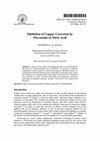Health Risk Assessment for Trace Metals, Polycyclic Aromatic Hydrocarbons and Trihalomethanes in Drinking Water of Cankiri, Turkey
引用次数: 43
Abstract
Lifetime exposure to trace metals, pesticides, polycyclic aromatic hydrocarbons (PAHs), trihalomethanes (THMs), and the other chemicals in drinking water through ingestion, and dermal contact may pose risks to human health. In this study, drinking water samples were collected from 50 sampling sites from Cankiri and its towns during 2010. The concentrations of all pollutants were analyzed, and then compared with permissible limits set by Turkish and WHO. For health risk assessment of trace metals, chronic daily intakes (CDIs) via ingestion and dermal contact, hazard quotient (HQ), and hazard index (HI) were calculated by using statistical formulas. For ingestion pathway, the maximum HQ values of As-non cancer in central Cankiri and Kursunlu town were higher than one. Considering dermal adsorption pathway, the mean and maximum HQ values were below one. HI values of As-non cancer in central Cankiri and Kursunlu town were also higher than one. Each trace metal (As-non cancer, B, Cd, Cr, Pb, and Sb) of the mean HI values were slightly below unity. Risks of As, PAHs, THMs, and benzene on human health were then evaluated using carcinogenic risk (CR). It is indicated that CRs of As and THMs were also found >10−5 in drinking water of Cankiri might exert potential carcinogenic risk for people. These assessments would point out required drinking water treatment strategy to ensure safety of consumers.土耳其坎基里市饮用水中痕量金属、多环芳烃和三卤甲烷的健康风险评估
通过摄入和皮肤接触,终生接触饮用水中的微量金属、农药、多环芳烃(PAHs)、三卤甲烷(THMs)和其他化学物质,可能对人类健康构成风险。在这项研究中,2010年从坎基里及其城镇的50个采样点收集了饮用水样本。分析了所有污染物的浓度,然后与土耳其和世界卫生组织规定的允许限值进行了比较。对微量金属进行健康风险评价,采用统计公式计算人体通过摄入和皮肤接触的慢性日摄入量(cdi)、危害商(HQ)和危害指数(HI)。在摄入途径上,中部坎基里镇和库尔孙鲁镇砷非癌最大HQ值均大于1。考虑真皮吸附途径,HQ值均值和最大值均小于1。中部坎基里镇和库尔孙鲁镇As-non - cancer的HI值也大于1。各微量金属(As-non - cancer、B、Cd、Cr、Pb、Sb)的平均HI值均略低于1。然后使用致癌风险(CR)评估砷、多环芳烃、THMs和苯对人类健康的风险。提示在Cankiri的饮用水中也发现了As和THMs的cr值bbb10 - 5,可能对人有潜在的致癌风险。这些评估将指出所需的饮用水处理战略,以确保消费者的安全。
本文章由计算机程序翻译,如有差异,请以英文原文为准。
求助全文
约1分钟内获得全文
求助全文

 求助内容:
求助内容: 应助结果提醒方式:
应助结果提醒方式:


